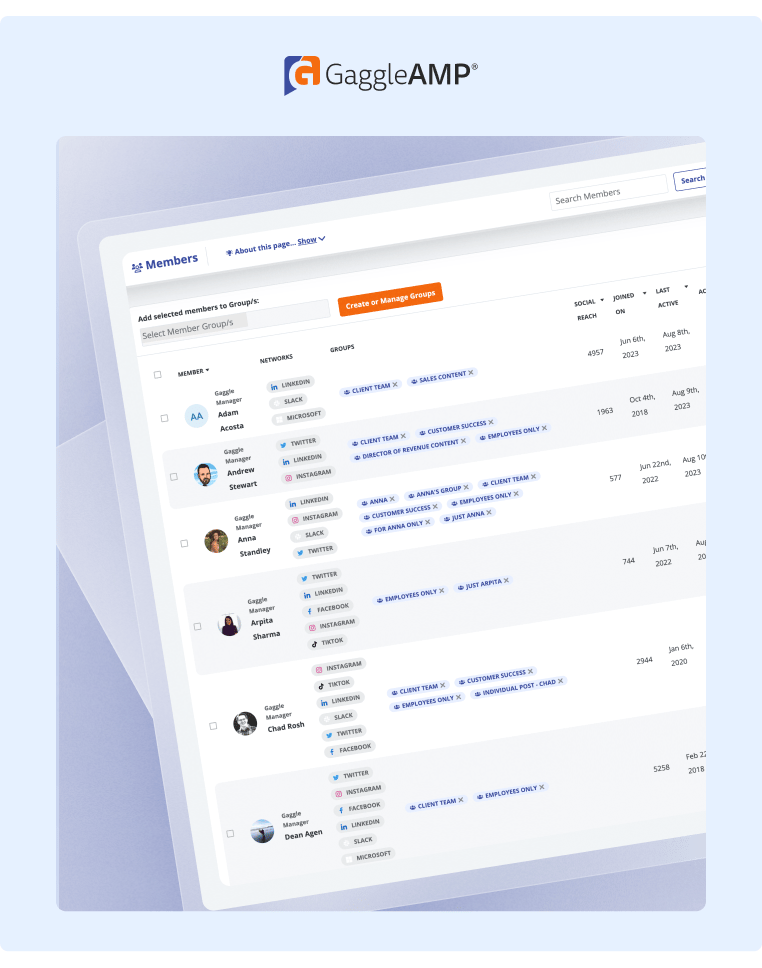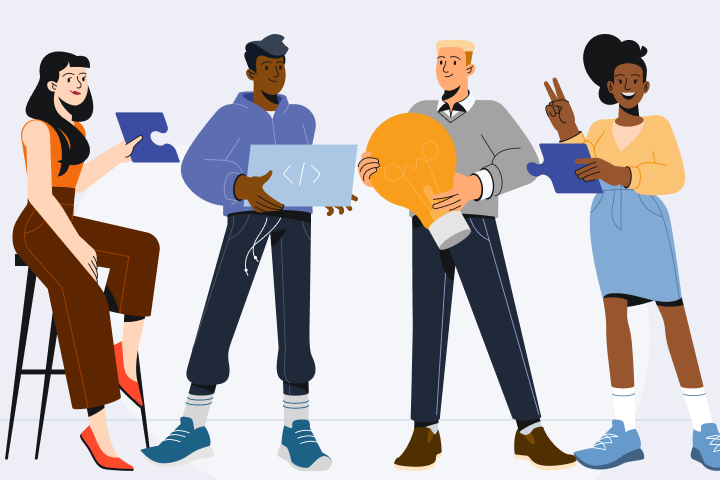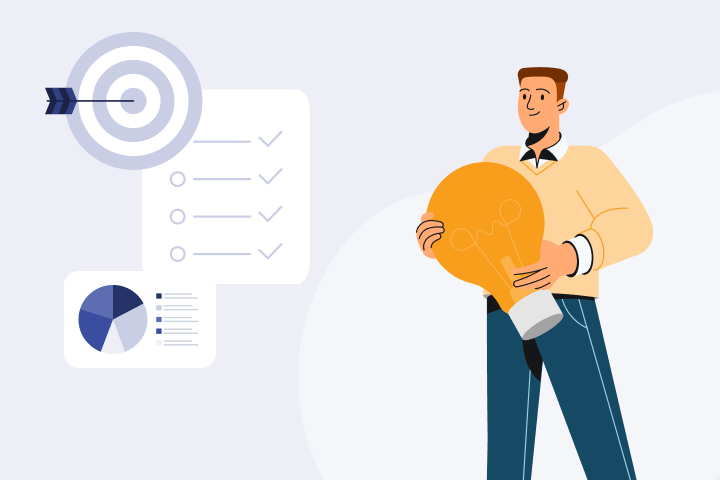How To Build a Highly Engaged Brand Ambassador Program
Most marketers are excited by the benefits of brand ambassador programs, like free brand awareness, high-quality word-of-mouth marketing, and more sales.
However, simply asking your most loyal employees and customers to promote your brand on social media and throughout their friend groups usually doesn't yield the benefits you were expecting.
While many brand ambassadors will promote your brand for the first few weeks, engagement typically drops off over time, forcing marketers to spend hours sending engagement requests that fall on deaf ears.
As a result, many brands give up on their brand ambassador efforts.
The good news is that poor engagement typically stems from poor ambassador program architecture. Specifically, most ambassadors stop engaging because they don't know what to say, when to engage, or where to promote your brand.
In this post, we'll show you how to create a highly engaged and sustainable brand ambassador program that allows you to reap the benefits of brand ambassadors.
We'll also provide several examples of successful brand ambassador programs you can use as models for your program.
What Is a Brand Ambassador Program?
A brand ambassador program is a marketing strategy that leverages existing fans (typically employees, customers, or partners) to promote it to their network, usually either through word-of-mouth or online via social media.
Brand ambassador programs are popular because they're cost-effective and can produce an excellent ROI, as each ambassador has already built a network of loyal friends and followers that trust their recommendations.
Unlike paid advertising and other marketing channels that require the brand to build trust with the audience, brand ambassadors have already spent years building that trust and therefore drive high-quality awareness.
Who Are Brand Ambassadors?
Brand ambassadors are usually customers, employees, and business partners who love and support your brand.

Influencers or micro-influencers can also be brand ambassadors, though these terms aren't synonymous.
The main difference between brand influencer programs and brand ambassador programs is that a brand ambassador is usually already a fan of your brand rather than someone you seek out to promote the brand (e.g, an influencer).
Additionally, to become a brand ambassador, you don’t necessarily need a large following like an influencer.
While you can require your ambassadors to have a certain follower count, most employees and customers (who typically make up most of your brand ambassador base) lack followings large enough to be considered influencers or micro-influencers. Instead, brand ambassador programs often rely on a high volume of loyal advocates to spread the word to their friends and family.
As brand ambassadors often lack the follower count to be considered influencers, they're typically cheaper than using influencers. Most are happy to promote your brand for discounts or free products, whereas influencer marketing can be expensive.
The ROI of Brand Ambassador Programs
Some statistics claim that the average ROI of a brand ambassador program is about 6.5x. In other words, you’ll make $6.50 for every $1.00 invested in your brand ambassador program.
In our experience, we've found that every brand runs its program differently, and those that take a more structured approach to building a brand ambassador program typically see a much higher ROI.
Therefore, instead of pinpointing a specific number you can target, let's look at a few of the factors that impact the ROI of your program:
- The number of ambassadors in your program.
- The promotion frequency and quality from your ambassadors.
- Each ambassador's audience size, loyalty, and relevancy.
- The cost of the incentive you provide to ambassadors.
As you're trying to improve the ROI of your ambassador program, think about how you can adjust those levers to meet your goals.
Now that you know what to expect from a brand ambassador program, let's discuss how you can actually run a brand ambassador program.
How To Run a Brand Ambassador Program
Once you know how to start a brand ambassador program, like any other marketing campaign, running a brand ambassador program is straightforward (once you create systems and processes). Here's everything you need to structure a successful brand ambassador program.
1. Establish Clear Goals for Your Brand Ambassador Program
Starting a formal brand ambassador program will probably require you to get buy-in from leadership, so you'll need to establish some goals.
First, some metrics a brand ambassador program can improve include:
- Brand Awareness (branded search queries and social mentions).
- Social Media Engagement/Follower Count.
- Website Traffic.
- Share of Voice.
- Backlink Profiles.
Now, instead of setting goals based on industry benchmarks, look at your current numbers for each of those metrics. Then, select a goal that is 10-15% lift (depending on your company's size and what's realistic).
Once you have clear goals, you'll be able to measure the success of your brand ambassador program, which will help you improve it over time.
2. Identify Your Brand Ambassadors
You can find brand ambassadors by looking at your list of employees, partners, and customers.
However, if you have hundreds or thousands of customers, employees, and partners, the thought of getting all of them to participate in your brand ambassador program can be overwhelming and you might give up before you ever start.
Instead, identify just a few key people within each group to promote your brand.
Let's discuss how to do this for each ambassador group.
Employees
Start by looking at your list of executives. They usually have the largest audiences and the most interest in the company's success, making them excellent brand ambassadors.
Once you've identified important executives, the next best set of employees to include in your program are those with large, relevant followings.

For most B2B companies, their B2B ambassador program will probably include LinkedIn or Twitter, but B2C brands may find that their employees with large TikTok, Instagram, or even Facebook audiences are the best potential brand ambassadors.
If you have a tool like GaggleAMP, you can quickly sort through your list of (enrolled) employees and see who has the largest, most engaged following by platform.

Partners
As you evaluate the best partners to reach out to, consider their social media follower count, email list size, and audience relevance.
Audience relevance is the most important of the three factors, as a large follower count is meaningless if none of them are your ideal customers.
It's also important to target potential partners with similar audience sizes, as the partnership won't be mutually beneficial for significantly larger brands, and those that agree to participate may soon drop out.
Customers
The best customer brand ambassadors have a substantial, loyal following of your ideal customers.
You can identify these customers by using a social media listening tool and following branded hashtags (some social listening tools even provide a list of your social media followers with the largest audiences).
Once you've created a list of potential brand ambassadors, reach out to a handful of them to participate in a beta version of your brand ambassador program. Select just 10 to 20 people for your initial program iteration and gather feedback before adding more people. This will help you iron out any issues before rolling out the program to a larger group of ambassadors.
3. Onboard Your New Brand Ambassadors
After identifying potential brand ambassadors, most marketers reach out with a generic pitch and ask the person if they'd consider becoming a brand ambassador.
If the person says "yes," you might send a packet of brand information and ask them to promote the brand and new products, but there typically aren't any clear action items.
As a result, the brand ambassador usually quits engaging after a few weeks, and the entire brand ambassador program falls flat.
Instead, consider purchasing an ambassador or employee advocacy platform like GaggleAMP that makes sending small, specific action items in real time easy.
To get started, you'll add your brand ambassadors to the platform. Then, you can create specific engagement activities with details like which platform to engage on (LinkedIn, Twitter, etc.), a link to a specific social media post, and how to engage with it (like, comment, share, etc.). You can even use our AI-powered writing tool to insert pre-written and approved text so that ambassadors just have to hit "publish."

When you finish filling out the engagement activity, assign it to the group or individual brand ambassadors, and they'll receive a notification via Slack, Microsoft Teams, or email. Then, they can log into their personal Gaggle, review the engagement activities, and schedule them for publishing.
This process eliminates most of the work for brand ambassadors, since they don't have to consider what platform to post on, when to post, or even what to say. They just have to hit "publish."
By removing the effort required of ambassadors to participate in your program, it's easy to maintain high engagement rates for an extended period of time.
4. Reward Your Brand Ambassadors
To keep your brand ambassadors motivated and engaged, GaggleAMP offers a public leaderboard that tracks engagement.
For example, you can assign points to each engagement activity, and GaggleAMP automatically awards the corresponding points to that ambassador when they complete the activity.
Then, GaggleAMP tallies up each ambassador's points and ranks all of your ambassadors in a public leaderboard.

The leaderboard encourages friendly competition among ambassadors, which helps increase program engagement. You can also incentivize people by offering a reward to ambassadors at the top of the leaderboard or anyone who earns above a certain threshold of points.
Your reward can be anything from an Amazon gift card to free products or services.
5. Track Your Progress and Improve Your Program
Give your program a few months (three to six) to gather data before making adjustments. You'll probably have some kinks to work out in the beginning, but once you've collected some data, reassess the following metrics:
- Brand Awareness (branded search queries and social mentions).
- Social Media Engagement/Follower Count.
- Website Traffic.
- Share of Voice.
- Backlinks.
Ideally, your metrics are trending in the right direction. Even if you haven't hit your goals yet, look at the compounding growth to estimate when you'll hit those goals.
Once you have a general overview of your program's performance, look for patterns in the brand ambassadors who generated the most engagement and double down on getting more people with similar followings to participate in future programs.
You can also analyze the strategies they used to promote your brand and encourage other ambassadors to adopt similar strategies.
Here are a few great questions to ask as you analyze the top performers' strategies:
- How frequently did they post?
- Were there any patterns in the medium they used (video, audio, text, etc.)?
- Were there any patterns in their post structure?
- Which incentives kept them the most motivated?
- Which platforms did they use the most to promote our brand?
- Any other commonalities that separate them from the rest of the ambassadors?
Once you identify what makes them different from the other brand ambassadors, you can double down on finding more brand ambassadors like them.
Examples of Brand Ambassador Programs
If you're looking for inspiration to structure your brand ambassador program, here are a few excellent brand ambassador program examples:
GoPro
GoPro's marketing department is known for consistently producing outstanding user-generated content campaigns, so it's no surprise they have an outstanding social ambassador program.
However, GoPro has a clever approach to recruiting new ambassadors. Instead of opening up the program to anyone with a social media following, they targeted a specific subset of potential customers (Boy Scouts). Then they allowed anyone to submit an audition video.
In fact, applicants don't even have to submit a video shot on a GoPro. The marketing team was purely looking for people who produce outstanding video content and are actively involved with their target market (Boy Scouts).
Then, the winners receive a free GoPro and join the roster of approved brand ambassadors.

Source: GoPro
Some key takeaways from GoPro's social ambassador program include:
- Prioritize ambassadors with a strong relationship with your ideal customer segment rather than just those with large social media followings.
- Prioritize ambassadors who are outstanding content creators, so you can use their content for other marketing campaigns.
- Rather than offering a standard application process, make it a fun contest and ask people to apply by using your hashtag. This will also help your brand receive more reach.
Red Bull
Red Bull knows that many of their most loyal customers are college students. They also know that these customers have little money and a lot of friends – the perfect candidate for brand ambassadorship as they'll likely accept minimal payment (often in the form of free products) in exchange for brand promotion.
Red Bull also does an excellent job structuring its ambassador program. First, you can see that they have established systems and processes to help brand ambassadors succeed.

Source: Red Bull
If you don't provide specific instructions for promoting your product, your ambassadors might not know what to say or do, and your program will probably flop.
Red Bull also avidly promotes its ambassador program in the same way most companies promote job opportunities. So if you want more high quality ambassadors promoting your brand, treat it like a job recruiting campaign.
Lululemon
Lululemon's ambassador program has been a core part of its marketing strategy for the past several years. They select anyone who is actively involved in the community, including yoga instructors, teachers, chefs, and other active leaders.
Members of the ambassador program receive free clothes and help promote the brand through word-of-mouth marketing.
Unlike many other brands, Lululemon doesn't offer applications for its ambassador program. Instead, their local store employees reach out to leaders within the local community who have extensive social networks and are also loyal customers.
Here's a video clip of a brand ambassador discussing how she became a Lululemon ambassador:
The ambassador program is different from their influencer and affiliate programs. Those members pay for their own products and then only receive a commission on the referrals they send.
American Family Insurance
It might be easy to get brand ambassadors if you have a fun product like workout clothes or makeup, but what if you have a somewhat boring product like insurance?
American Family Insurance has built a thriving ambassador program that primarily works with micro-celebrities like Derek Jeter, The Scott Brothers, and Kathy Ireland.

Source: American Family Insurance
While we mentioned earlier that brand ambassadors aren’t necessarily celebrities, this is an excellent example where the best ambassadors are minor celebrities simply because it's difficult to recruit customers to actively promote a product like life insurance.
If you're struggling to get brand ambassadors, consider partnering with influencers who have built trust with your ideal target audience and offer them ambassadorship.
American Family Insurance also collaborates with some of their partner brands, like Dreambank, to promote the brand.
Finally, their employees are also a large part of their brand ambassador program as they regularly share company news and events with their networks on social media:

Source: Amelia Wampler
Omaha Steaks
The best brand ambassadors are often your employees, as they’ve already dedicated most of their waking hours to your goals and mission. So, consider employing a company ambassador program(s).
Omaha Steaks is an excellent example of a brand that leverages its employees to promote the brand for them. In fact, they call the program the All-Char Team, and you’ll regularly see these employee ambassadors bragging about their company on social media:

Source: Ashley Lemke
In addition to actively posting about the brand, they regularly share company content to boost brand recognition and help grow its social media presence.

Source: Kati Davis-Shovlin
Start Your Brand Ambassador Program Today
A brand ambassador program can help you increase brand awareness, drive sales, and improve customer loyalty. But many marketers find it difficult to keep ambassadors engaged for an extended period of time.
We’ve discovered that the key to sustainable ambassador engagement is reducing the effort required for ambassadors to participate in your program.
Therefore, we built GaggleAMP to make it easier for brand ambassadors to engage by allowing managers to assign specific engagement activities.
This way, brand ambassadors don’t have to decide what to say, where to post, or how often to promote your brand. In addition, you have more control over how brand ambassadors present your brand by providing specific engagement activities.
You can learn more about how GaggleAMP can help you improve your brand’s awareness by scheduling a demo today.











